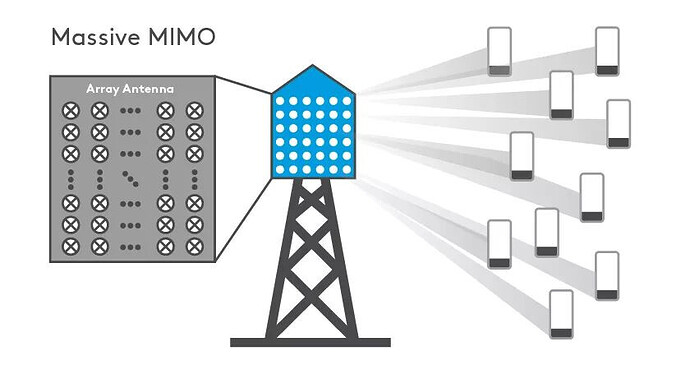MIMO (Multiple-Input, Multiple-Output) systems are not simply about adding more antennas, they’re about ensuring those antennas contribute independently and efficiently. Without managing spatial correlation and mutual coupling, increasing antenna count can degrade system performance instead of improving it.
- Understanding Spatial Correlation:
- Spatial correlation arises when antennas receive similar signals due to insufficient spacing or poor scattering.
- Mathematically, the correlation coefficient ρ between antenna elements is:
→ ρ = |E{h₁·h₂*}| / √(E{|h₁|²}·E{|h₂|²})
where h₁ and h₂ are complex channel responses. - High ρ reduces the rank of the MIMO channel matrix H, limiting multiplexing and diversity gain.
- Ideal designs maintain ρ < 0.5 for practical diversity.
- Channel capacity with spatial correlation is given by:
→ C = log₂ det(I + (ρ/σ²)·H·Hᴴ)
where σ² is noise variance.
- Mutual Coupling and Its Impact:
- Mutual coupling occurs when current in one antenna induces current in nearby elements.
- It modifies input impedance:
→ Z_in (mutual) = Z_self + Σ Z_mutual - Coupling distorts embedded radiation patterns and reduces total efficiency η:
→ η_total = P_rad / P_input = η_rad × (1 − |S11|² − |S21|² − …) - S-parameters like S21 are critical: |S21| > −10 dB indicates strong coupling.
- Coupling alters current distribution, leading to polarization mismatch and increased correlation.
- Engineering Trade-Offs and Techniques:
- Maintain spacing ≥ λ/2 to reduce both correlation and coupling.
- Use neutralization lines, decoupling networks, or EBG/AMC structures to suppress S21.
- Cross-polarized or orthogonally oriented antennas reduce pattern similarity.
- Simulate envelope correlation coefficient (ECC) from far-field patterns:
→ ECC ≈ |∬ E₁(θ,ϕ)·E₂*(θ,ϕ) dΩ|² / (∬ |E₁|² dΩ · ∬ |E₂|² dΩ) - Use eigenvalue decomposition of H to verify spatial diversity: If λ₁ ≈ λ₂ ≈ … ≈ λ_n, spatial modes are well-isolated.
- Real-World Examples:
- Smartphone MIMO arrays use corner positioning and metal frames as isolation structures.
- Automotive radars at 77 GHz employ T-shaped and corner-fed layouts to minimize coupling in limited space.
- Massive MIMO base stations utilize cross-polar elements with λ spacing to achieve low ECC and full-rank channel matrices.
- Wi-Fi 6E and 7 APs integrate hybrid directional arrays with in-device coexistence filters to mitigate coupling across tri-band MIMO systems.
Efficient MIMO isn’t about more, it’s about independent. Understanding spatial correlation and coupling is key to unlocking the real capacity of modern wireless systems.
LinkedIn: ![]()
